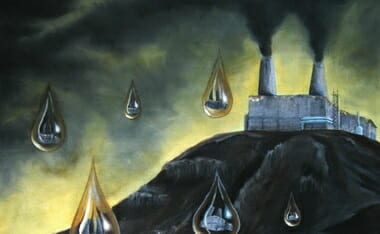ABSTRACT
Acid rain first came to public attention with claims that it was rapidly killing forests and lakes on a broad basis. To assess the accuracy of these claims, Congress initiated the largest study to date of an environmental problem: the ten-year, $500′-million National Acid Precipitation Assessment Program (NAPAP), which involved over three thousand scientists. NAPAP determined that acid rain may present a threat to one species of tree in 0.1 percent of eastern forests. The percentage of acidic lakes was also found to be much smaller than previously believed and not measurably increasing. Nevertheless, these scientific findings had little apparent impact on legislation passed in 1990, having been judged by some to be “not policy relevant.”
INTRODUCTION
George Will’s column of January 8, 1992, indicates that mainstream journalists are beginning to get the idea that in the hands of environmental advocates, estimates of environmental damage take on lives of their own, with few ties to reality. In the column, Mr. Will mused, “Whose interests are served by a numerical exaggeration? The answer often is: the people whose funding or political importance varies directly with the perceived severity of a particular problem” (Will, 1992).
Just about everyone of public importance had some sort of stake in acid rain being an environmental Armageddon. The scientific reality of the effects of acid rain differ enormously from public perception. And this is important for the setting of environmental policy because, unlike scientific fact, political reality in a democracy is established by vote.
The enormous gulf between fact and perception was brought out in the 60 Minutes story on acid rain (December 30, 1990). Correspondent Steve Kroft asked Dr. James Mahoney (then director of NAPAP) about the media representing acid rain as making a “silent spring” in the forests and lakes of the Northeastern United States. Director Mahoney commented that the media accounts of damage were overblown by quite a bit. When pressed why such fiction, rather than science, is being reported, Dr. Mahoney refused to address this issue and answered that his job is to do the science, not the reporting.
Yet the EPA had no such reservations about commenting, and commenting strongly, on media reporting. The EPA blasted the 60 Minutes acid rain story in a lengthy and detailed response claiming that outrageous statements were made (EPA, 1991). Let us examine the peculiar responses of the EPA, our public servant of environmental policy.
As a scientist, I can see how the EPA would have been upset by some of the comments made on 60 Minutes. The EPA is the lead federal agency of NAPAP. EPA Administrator Reilly is chairman of the President’s Joint Chairs Council, which oversees NAPAP. So I would have thought that the EPA would have been upset by the remark of David Hawkins (an activist for the Natural Resources Defense Council) who in effect told 60 Minutes that NAPAP has been a waste of time and money. And further, he said that in its ten years of existence, NAPAP has only confirmed what was known ten years ago!
Peculiarly, the EPA did not indicate any offense at all with this statement. But as a NAPAP scientist, I certainly was offended. We must remember that the United States almost did not have a NAPAP. In 1980, public opinion was very strong against waiting ten years for NAPAP to complete its study. Environmental activists established the conventional wisdom that by 1990 it would be too late: Rachael Carson’s prophesy of a “silent spring” would come to pass, with acid rain forever killing forests and lakes, by 1990.
Only a recalcitrant President Reagan, allied with Midwest rust-belt legislators, stood in the way of environmentalists’ demands. But the pressure became even too much for President Reagan who, by the end of 1983, was ready to capitulate. In late January/early February 1984, I was one of a committee of scientists who were asked to advise EPA Administrator Ruckelshaus on the choice of continuing research on acid rain or passing a new Clean Air Act. What the government would do hinged on how we answered the following question: will eastern North America survive five more years (will it survive until 1989) under the fierce onslaught of acid rain? The question seems ludicrous now, but back in 1984, it was considered foolish and immoral for anyone to even ask this question. President Reagan stayed with NAPAP.
Now we know that NAPAP’s findings did not confirm what was known ten years ago in 1980, as Mr. Hawkins claimed. And Mr. Hawkins of the Natural Resources Defense Council is in the position to know this firsthand because this is the same Mr. Hawkins who was appointed by President Carter as the EPA assistant administrator responsible for acid rain. President Carter, then Mr. Hawkins’s boss, told the American public in 1980 that acid rain was one of the two most severe atmospheric environmental problems of the century. And Mr. Hawkins’s EPA lent the appearance of scientific credibility to President Carter’s assertion by publishing that the average Northeast lake had been acidified a hundredfold over just the last forty years as the result of acid rain (EPA, 1980)—a statement that has no basis in fact. Yet, by 1990 the EPA’s own research, as part of NAPAP, showed that, even in the Adirondacks, the area whose lakes are supposed to suffer the greatest acidification by acid rain, EPA data show that the average lake is no more acidic now than it was before the industrial era (Krug and Warnick, 1991).
The EPA produced a six-page, single-spaced rebuttal to what it considered outrageous statements made on 60 Minutes (EPA, 1991). Was the EPA response to 60 Minutes concerned about Hawkins’s assertion about wasted research dollars? No. Or about research results substantiating the public perception of 1980? No.
Yet EPA Administrator Reilly wrote in a letter to Science: “In the Senate hearings on my confirmation as EPA Administrator, the first criterion that I mentioned for an effective environmental policy was ‘respect for science'” (Reilly, 1990).
I could understand if Mr. Reilly were concerned about Mr. Hawkins having a less-than-respectful attitude for science on 60 Minutes when he said that NAPAP scientists were unable to see damage because we have very crude scientific tools but that the American public can look out their windows and see the damage being done. Mr. Hawkins then went on to characterize us as backpacking around in the woods.
Yet again, the EPA, which considers itself to be a scientific agency and is the lead agency of NAPAP, an agency whose administrator publically claims to have “respect for science,” did not indicate any offense at all with this statement.
What really offended the EPA? I was asked to comment on Mr. Hawkins’s characterization of us NAPAP scientists as not being able to see anything because we were larking around in the woods with crude scientific tools. I responded, “Actually we do know a lot. We know that the acid rain problem is so small that it’s hard to sec.”
The EPA took great offense to that statement.
The EPA promptly carried out an ad hominem attack on me! This was done even though I have letters from the EPA itself calling me a recognized leader in acid rain—even though I have been used by the EPA itself to review its acid rain programs, and I have even been used to advise Administrators Ruckelshaus and Thomas of the EPA about acid rain.
The EPA also released comments from an alleged peer review of a project report I published for NAPAP two years earlier. I call it an alleged peer review because:
- The first time I had heard of it was when a Washington Post reporter called me up on January 11, 1991—twenty-one months after the report was published.
- The report was peer-reviewed by NAPAP prior to publication. The EPA’s comments did not come from the NAPAP review of the report.
- I have yet to see a copy of this alleged peer review even after making a freedom of information request on January 14, 1991, to EPA Administrator Reilly to see it.
We can now begin to understand why the scientists who conducted the Adirondack lakes study for the EPA—the study that showed no net acidification—refused to publish this result. Similarly, the results of the EPA’s largest acidification research project—where no correlation could be found between acid rain and surface water acidity, and soil chemistry is the principal factor controlling the acidity of surface waters (EPA, 1989)—was not published by EPA scientists in the scientific literature. So, after waiting for up to two years for these data to be published, I finally published them in a letter to Science last fall (Krug and Warnick, 1991).
We see that, as public servants and as holders of the public trust, the EPA is unconcerned about public misinformation that exaggerates acid rain as an environmental problem. The EPA is unconcerned about science bashing in the media. Indeed, the EPA even partakes in it.
In conclusion, George Will’s column of January 8 hit the nail on the head: in the hands of environmental advocates, estimates of environmental damage take on lives of their own, with few ties to reality. As Mr. Will concludes, those who exaggerate are those whose funding or political importance varies directly with the perceived severity of a particular problem.
The reason why the public is so well misinformed on acid rain is that the environmental advocates are not just Greenpeace and the Sierra Club. Just about everybody gains from the acid rain myth—everybody, that is, except you and me. The EPA likes it because, in terms of regulation, the 1990 Clean Air Act is ten times bigger than any previous environmental legislation, including the Clean Air Act of 1970. The government likes it because it gains more popularity, power, and control as government is seen doing something good for little cost; most environmental costs are off budget, being paid directly by the consumer. The media likes it because environmentalism is a just cause depicted in terms of good-versus-evil, David-versus-Goliath battles. Environmentalists hand the media popular and spectacular disaster stories pitting the blue-jeaned defenders of Mother Earth from the three-piece-suit Darth Vaders of big business, in this case, utilities spewing forth acid rain. The utilities like it because they get to pass on higher utility rates, along with increased profits, from the Public Utility Commissions onto you and me because we, the well-misinformed public, are demanding to be protected from the scourge of acid rain.
What a sweet setup!
Small wonder why scientists refuse to publish data showing acid rain has little or no measurable effect. When another acid rain scientist was asked by a magazine reporter why Ed Krug would take it upon himself to publish politically incorrect science, my colleague replied, “He was a bit immature in the area of political science” (Anderson, 1992).
On that note, let us quickly examine what political science has done to the science of acid rain.
POLITICAL SCIENCE: HISTORY
It is a little-known fact that the European and American acid deposition monitoring networks originated in the national agricultural experiment stations; these have been sampling and analyzing atmospheric deposition of N [nitrogen] and S [sulfur] for more than a century, not as contaminants but as beneficial nutrients (Krug, 1991). Among agronomists, such “pollution” was often called the poor man’s fertilizer. In Sweden, the world’s first national acid rain study determined that the principal effect of acid rain was improvement of crop yield and crop protein content (e.g., Johansson, 1959).
However, the insertion of the term “acid rain” into the modern literature and psyche by Likens and associates in 1972 “caught the attention of the scientific community as well as the public at large” (Abdullah, 1989). The deposition. How could anything called “acid rain” be anything but bad? So the results of the Swedish program became lost in history, and any scientist who brought up the point that acid rain might have a good side was ridiculed into oblivion.
Later on, NAPAP would report on the fertilizing effect of acid rain on forests, but would emphasize the negative potential of it. Fertilization of high altitude forest by acid rain, 0.1 percent of our eastern forests, may be increasing cold damage by making forests grow too long into the winter. The potential beneficial effects of fertilization on the remaining 99.9 percent of eastern forests remain safely buried in voluminous technical reports—reports little read by interested specialists, let alone by policy makers and the public.
Around the time that Likens and associates used two little words to permanently change the way that we think about deposition of N and S, the Norwegian national acid rain program came into existence.
The Norwegian national acid rain program of the 1970s, not the Swedish program of the 1940s and ’50s, established the research perspective of the subsequent American, Canadian, and European national acid rain programs. Regrettably, the proposal (Nr. 172/1974) to the Norwegian parliament for financing the program stated that “the aim of the project is to provide material for negotiations in order to limit the emission of SO2 in Europe” (Rosenqvist, 1990). Thus, scientific objectivity was lost from the inception; politicians proclaimed that acid rain is a problem and would pay those scientists who would support the political position.
Thus, political correctness came to acid rain twenty years ago.
A similar situation was manufactured in the United States. As the Norwegian program was ending in 1980, President Carter called acid rain one of the two atmospheric environmental crises of the century and started NAPAP at $10 million per year for ten years.
Thus, the inception of NAPAP was hardly scientifically objective either. And, at $10 million per year, NAPAP was merely window dressing to provide the appearance of scientific credibility for the claims of environmental disaster.
Remember, NAPAP was supposed to be investigating the sources of acid rain, its atmospheric chemistry and transport, as well as its myriad claimed effects, such as visibility, effects on crops, effects on forests, effects on lakes, effects on buildings, effects on human health. Then you take all of these effect and research areas and divide them among all of the participating agencies: the US Park Service, the US Geological Survey, the US Forest Service, the Tennessee Valley Authority, the US Department of Agriculture re, National Oceanic and Atmospheric Administration, National Aeronautics and Space Administration, the national laboratories, Department of Health and Human Services, Department of Energy, Department of Commerce, and (last but not least) the Environmental Protection Agency, and you see that $10 million per year will hardly pay the salaries of the administrative paper pushers, let alone support any meaningful research.
NAPAP was originally set up to put a rubber stamp on the false claims of disaster. It was not set up to do science.
This changed after 1984, when the Reagan administration asked for scientific rather than political opinion. We scientists reported to the administration that, contrary to popular belief, the world was nor going to end soon because of acid rain. Please let us do the science.
President Reagan’s response was not to push for a new version of the Clean Air Act. Not only did he continue NAPAP, but he increased NAPAP’s budget tenfold to around $100 million per year so that it could finally get around to doing meaningful scientific research on acid rain.
With the new budget and the emphasis now being on science, NAPAP also got a scientist to be its new director, Lawrence Kulp, a former director of the Lamont Geochemical Laboratory at Columbia University.
This made environmentalists furious. NAPAP became distinct from all other national acid rain programs: it was evolving into a scientific entity rather than remaining a creature of environmental politics. Since NAPAP was no longer likely to rubber stamp the claims of disaster, environmental activists would discredit NAPAP with the help of its powerful allies in the media and government, which most importantly included the EPA. And the EPA was NAPAP’s lead federal agency.
Thus NAPAP was not able to produce perfectly objective science. However, we must commend NAPAP for performing far better than we have any right to expect; NAPAP was overwhelmingly besieged from both within and without.
You can measure the success of NAPAP by environmentalists criticism of it and their vehement objections to the establishment of a “NAPAP” for global warming….


